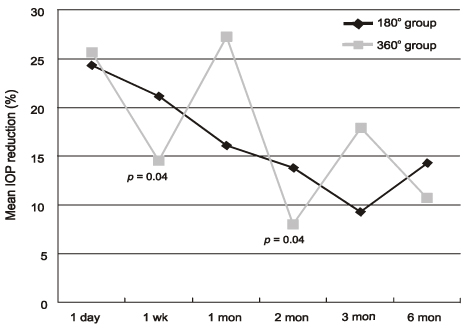J Korean Ophthalmol Soc.
2012 Feb;53(2):291-296.
Comparison of 180degrees and 360degrees Selective Laser Trabeculoplasty
- Affiliations
-
- 1Department of Ophthalmology, Kim's Eye Hospital, Myung-Gok Eye Research Institute, Konyang University, Seoul, Korea.
- 2Seoul Bright Eye Clinic, Seoul, Korea.
- 3WooRi Ophthalmic Clinic, Wonju, Korea. dog408@gmail.com
Abstract
- PURPOSE
To compare the effect and safety of two regimens of Selective Laser Trabeculoplasty (SLT), SLT on 180degrees of trabecular meshwork and SLT with 100 laser spots on 360degrees of trabecular meshwork in patients with primary open-angle glaucoma and ocular hypertension.
METHODS
In a retrospective clinical study, the authors compared the pressure-lowering effects of SLT in two groups of patients; group 1 (83 patients) received SLT on 180degrees, group 2 (30 patients) on 360degrees of trabecular meshwork. The clinical outcome indicators included intraocular pressure (IOP) at one day, one week, one month, two months, three months and six months after SLT, and the anterior chamber reaction at post-laser one day.
RESULTS
There was no statistically significant difference in the IOP reduction between these two regimens after six months. The anterior chamber reactions in the two groups were significantly different (group 1; 0.61 +/- 0.64, group 2; 1.25 +/- 0.83, p = 0.001). The success rate of group 2 (43.3%) was not different from that of group 1 (31.3%; p = 0.23).
CONCLUSIONS
SLT on 180degrees of trabecular meshwork had a similar effect compared to that of SLT on 360degrees of trabecular meshwork in terms of IOP reduction. The authors of the present study suggest that 180degrees SLT is the safest procedure with regard to success rate and complications.
MeSH Terms
Figure
Reference
-
1. van der Zypen E, Fankhauser F. Ultrastructural changes of the trabecular meshwork of the monkey (Macaca speciosa) following irradiation with argon laser light. Graefes Arch Clin Exp Ophthalmol. 1984. 221:249–261.2. van der Zypen E, Fankhauser F, England C, Kwasniewska S. Morphology of the trabecular meshwork within monkey (Macaca speciosa) eyes after irradiation with the free-running Nd:YAG laser. Ophthalmology. 1987. 94:171–179.3. Lai JS, Chua JK, Tham CC, Lam DS. Five-year follow up of selective laser trabeculoplasty in Chinese eyes. Clin Experiment Ophthalmol. 2004. 32:368–372.4. Kim JS, Lee YG, Hong YJ. Q-switched, frequency doubled Nd:YAG laser trabeculoplasty. J Korean Ophthalmol Soc. 1999. 40:2591–2596.5. Lee HY, Baek NH, Moon JI. Comparison of short-term outcomes of argon laser versus selective laser trabeculoplasty in open-angle glaucoma. J Korean Ophthalmol Soc. 2005. 46:2004–2009.6. Damji KF, Shah KC, Rock WJ, et al. Selective laser trabeculoplasty vs argon laser trabeculoplasty: a prospective randomised clinical trial. Br J Ophthalmol. 1999. 83:718–722.7. Moon SJ, Choi ES, Park JI, Lee KH. Two-year follow-up of selective laser trabeculoplasty as initial and adjunctive treatment for ocular hypertension and open Angle glaucoma. J Korean Ophthalmol Soc. 2010. 51:974–980.8. Juzych MS, Chopra V, Banitt MR, et al. Comparison of long-term outcomes of selective laser trabeculoplasty versus argon laser trabeculoplasty in open-angle glaucoma. Ophthalmology. 2004. 111:1853–1859.9. Noecker RJ, Kramer TR, Latina M, et al. Comparison of acute morphologic changes after selective laser trabeculoplasty and argon laser trabeculoplasty by electron microscopic evaluation. Invest Ophthalmol Vis Sci. 1998. 39:S472–S473.10. Suhk HJ, Kook MS. Three year follow up of laser trabeculoplasty using Q-switched frequency doubled Nd:YAG laser. J Korean Ophthalmol Soc. 2003. 44:93–99.11. Park MH, Moon JI. A comparison of efficacy and safety between 90° and 180° selective laser trabeculoplasty. J Korean Ophthalmol Soc. 2007. 48:1500–1505.12. Chen E, Golchin S, Blomdahl S. A comparison between 90 degrees and 180 degrees selective laser trabeculoplasty. J Glaucoma. 2004. 13:62–65.13. Weinand FS, Althen F. Long-term clinical results of selective laser trabeculoplasty in the treatment of primary open angle glaucoma. Eur J Ophthalmol. 2006. 16:100–104.14. Song J, Lee PP, Epstein DL, et al. High failure rate associated with 180 dgrees selective laser trabeculoplasty. J Glaucoma. 2005. 14:400–408.15. Prasad N, Murthy S, Dagianis JS, et al. A comparison of the intervisit intraocular pressure fluctuation after 180 and 360 degrees of selective laser trabeculoplasty (SLT) as a primary therapy in primary open angle glaucoma and ocular hypertension. J Glaucoma. 2009. 18:157–160.16. Stewart WC, Kolker AE, Sharpe ED, et al. Factors associated with long-term progression or stability in primary open-angle glaucoma. Am J Ophthalmol. 2000. 130:274–279.17. Barkana Y, Anis S, Liebmann J, et al. Clinical utility of intraocular pressure monitoring outside of normal office hours in patients with glaucoma. Arch Ophthalmol. 2006. 124:793–797.18. Robin AL. The role of apraclonidine hydrochloride in laser therapy for glaucoma. Trans Am Ophthalmol Soc. 1989. 87:729–761.
- Full Text Links
- Actions
-
Cited
- CITED
-
- Close
- Share
- Similar articles
-
- Short-Term Clinical Outcomes of Laser Trabeculoplasty Using a 577-nm Wavelength Laser
- Comparison of Short-term Outcomes of Argon Laser versus Selective Laser Trabeculoplasty in Open-Angle Glaucoma
- Comparison of Clinical Outcomes of Argon Laser Versus Selective Laser Trabeculoplasty in POAG
- Two-year Follow-up of Selective Laser Trabeculoplasty as Initial and Adjunctive Treatment for Ocular Hypertension and Open Angle Glaucoma
- The Effect of 1 % Apraclnidine on Intraocular Pressure Following Argon Laser Iridotomy and Laser Trabeculoplasty




